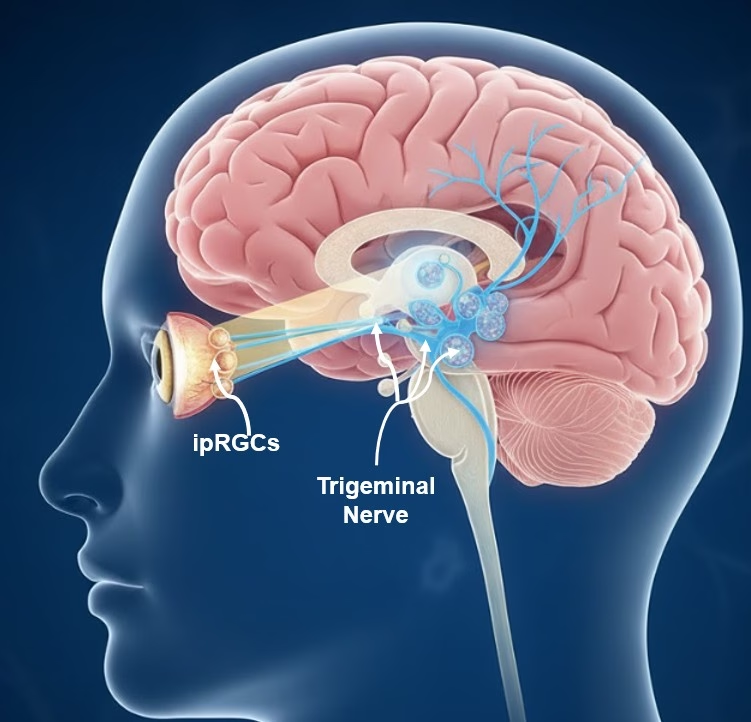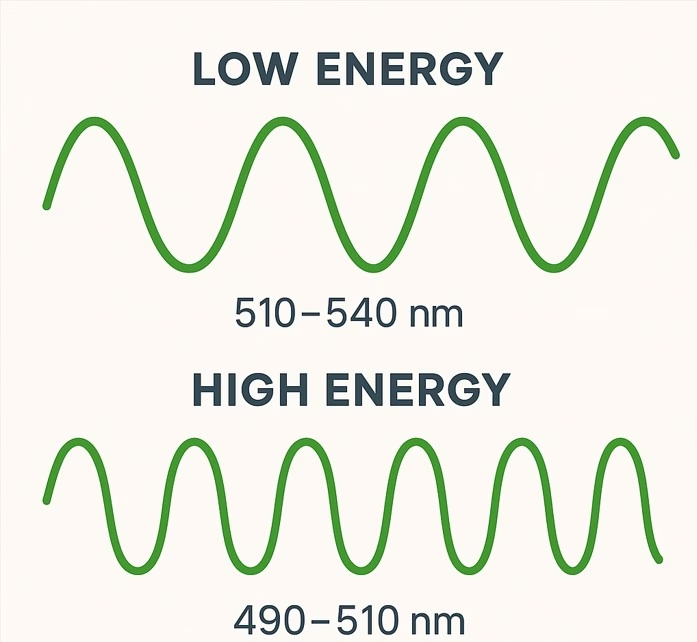
Post Disclaimer
The information on this website is designed to offer self-care tips and recommendations based on evidence-based research and literature from professionals in each field. It is not intended to diagnose or treat any specific medical condition. Please consult with your healthcare provider before making any health-related decisions.

For thousands of years, cultures around the world have explored the healing properties of light. Ancient Egyptians used sunlight for medical treatments. Early Greek and Roman physicians recommended specific times of day for sun exposure to improve mood and vitality. While their tools were simple, the healing capability has been around for years.
With modern medicine, powerful imaging tools, and an improved understanding of the brain and nervous system, we now know that light does far more than help us see. It can influence our hormones, our sleep cycle, our mood, and even how we feel pain. One development in this field is the use of specific wavelengths of green light to help reduce migraine pain. Let’s explore how this works and the products that support this research.
Understanding Migraines: What’s Happening Inside the Eyes and Brain
Migraines are not simply “bad headaches”; they are complex neurological events driven by heightened sensitivity in the brain’s sensory systems. One of these is photophobia, where even normal indoor lighting can feel piercing, overwhelming, or painfully intense. This reaction begins in the eyes and travels through specialized neural pathways into the brain, where light signals are interpreted and amplified.
While the exact cause is still being studied, genetics, early developmental brain wiring, overactive pain-receptor networks, and numerous environmental and lifestyle variables all play roles in creating a brain more vulnerable to migraine activation. These factors converge to shape how easily the visual system and pain circuits trigger an attack. To understand why light can feel so painful, we need to look at what happens the moment it enters the eye, how those signals reach the brain, and how they interact with migraine-sensitive pathways.
Specialized Eye Cells That Trigger Pain: The Role of ipRGCs

Inside the retina (the thin layer of tissue at the back of your eye) are many types of nerve cells. Among these are the intrinsically photosensitive Retinal Ganglion Cells (ipRGCs). Multiple regions of the brain automatically process the light-intensity data collected by ipRGCs, each transforming it into different biological responses. Of these, the seven major functional outcomes include: setting the circadian clock, controlling sleep–wake balance, regulating pupil size, shaping emotional/mood response to light, guiding orientation and attention toward stimuli, supporting brightness perception, and, most importantly, activating the trigeminovascular pain system, which can amplify migraine pain and explains the phenomena like the “tale of two nails,” where intense pain occurred when a nail passed through a man’s boot without touching his foot, showing that pain can arise purely from brain interpretation rather than tissue damage.
When someone with migraines encounters bright light, the ipRGCs become intensely activated. Because the migraine brain exists in a “sensitized” state, this incoming light signal is amplified and interpreted as pain, making light a powerful trigger or intensifier of symptoms. Over time, associative neural networks become conditioned to pair certain environmental cues, like specific lighting, places, or visual patterns, with pain, further strengthening the brain’s tendency to react defensively and heighten the pain response. Even with your eyes closed, these cells continue to sense light through the eyelids, keeping this pathway firing and worsening discomfort.
Which Light Makes Migraines Worse, and Why

Light is measured in nanometers (nm), which describes the distance between peaks of a light wave, similar to measuring the spacing between ripples on water (25.4 million nanometers per inch). Shorter wavelengths mean the peaks are closer together. Because of the physics of light, shorter wavelengths carry more energy, while longer wavelengths carry less. This is why violet, blue, and some higher-energy green light deliver more energetic stimulation to the eye and brain.
These shorter, higher-energy wavelengths amplify the ipRGC signaling, which is more likely to be interpreted as pain, making violet, blue, and some green light major contributors to migraines and symptom worsening.
Why Some Green Light Hurts… and Other Green Light Helps
Research shows that narrow-band green light (~510–540 nm) affects the brain very differently than other colors. While most bright light can aggravate migraine circuitry, this specific slice of green light delivers a gentler signal that avoids overstimulating the brain’s pain pathways. Because it doesn’t trigger the same intensity of electrical activity, the light is less likely to amplify signals that normally worsen migraine symptoms.
More importantly, narrow-band green light appears to activate the brain’s own opioid system, the natural pain-relief network that helps calm pain signals without medication. At the same time, it seems to reduce neuroinflammation, quieting overactive immune-related support cells in the brain that can contribute to chronic pain and sensitivity. This combination of enhanced natural pain relief and reduced inflammatory activity helps stabilize an already sensitive migraine nervous system, reducing pain intensity, frequency, and light sensitivity over time.
Because of these effects, lower stimulation, opioid-system engagement, and anti-neuroinflammatory signaling, narrow-band green light is emerging as a unique non-drug option that not only avoids making migraines worse, but may help the brain heal and regain better sensory balance.
Green-Light Technology: Tools That Put the Research to Work
Because narrow-band green light can calm migraine pathways, several products now apply this research. The two most common are specialty glasses and green-light lamps.
Green-light glasses filter incoming light so that irritating wavelengths (especially blue and parts of the green–yellow range) are blocked, while only the gentle, therapeutic green band is allowed through. This reduces overstimulation and helps decrease light-triggered migraine symptoms.
Green-light lamps do the opposite: instead of filtering, they emit only the helpful narrow-band green light, which many people use either daily to help prevent attacks or during a migraine to ease pain and sensitivity.
Green-Light Technology: Products Using Narrow-Band Science
Below are examples of glasses, lamps, and bulbs designed to apply narrow-band green-light research for migraine relief. Each product description includes a summary, supporting evidence, cost, and a purchase link. This article summarizes what is available based on the analysis of current studies. Please do your own research, consult appropriate professionals, and make the decision that feels right for you. This information is provided solely to help inform your choice.
When deciding whether to purchase glasses or lamps for narrow-band green-light therapy, look for products that clearly state their wavelength (~520 nm), ideally provide a spectrum graph, undergo third-party testing, and are supported by peer-reviewed or real-world studies. Check that usage instructions align with the research, and be cautious about over-promising claims. Light therapy remains an emerging tool and is best used as part of a broader migraine-management plan.
Avulux Migraine Glasses
The Avulux Migraine Glasses use precision-filtered lenses designed to block migraine-triggering wavelengths across the blue, amber, and red spectrum while allowing a soothing portion of green light to pass through. They are available in both prescription and non-prescription options.
Research: A randomized, double-blind trial titled “Targeting the Intrinsically Photosensitive Retinal Ganglion Cell to Reduce Headache Pain and Light Sensitivity in Migraine” demonstrated early evidence that migraine-filtering lenses may reduce headache pain and light sensitivity in 78 patients.
https://pubmed.ncbi.nlm.nih.gov/37150129/
Cost: $300–$400
Purchase Link: https://avulux.com/
GloFX Green Color-Therapy Glasses
GloFX offers budget-friendly green-tinted glasses intended for general comfort and color-therapy use. Although they are not engineered to filter migraine-specific wavelengths, some users report mild relief from eye strain and bright light discomfort.
Research: No migraine-specific clinical trials.
Cost: $15–$30
Purchase Link: https://glofx.com/
Hooga Green Light Therapy Lamp (~520 nm)
The Hooga Green Light Therapy Lamp emits narrow-band green light at approximately ~520 nm, placing it within the same wavelength range used in clinical migraine research. It is designed for home use and can be used preventively or during migraine attacks to reduce symptom intensity and photophobia.
Research: Supported by studies on narrow-band green light including the 2020 Cephalalgia trial evaluating green-light exposure for improving migraine headache frequency and intensity. https://pubmed.ncbi.nlm.nih.gov/32903062/
Cost: $70–$120
Purchase Link: https://hoogahealth.com/
NorbRELIEF Narrow-Band Green Light Bulb
The NorbRELIEF A19 Bulb is an affordable option engineered to produce a narrow-green spectrum without significant flicker. It can be used in standard lamps to create a calming environment with reduced triggering wavelengths.
Research: Aligned with Harvard/BIDMC narrow-band green-light findings (Brain, 2016) and real-world open-label reports; however, device-specific clinical studies are still limited. https://doi.org/10.1093/brain/aww119
Cost: $20–$40
Purchase Link: https://shop.norblighting.com/products/relief
Family Tree Remedies 520 nm Clip-On Light
This portable clip-on lamp provides a fixed 520 nm narrow-green signal—making it useful for bedside, reading, or targeted exposure while traveling. Because of its compact design, it offers accessible entry-level green-light therapy.
Research: Concept-aligned with research supporting the ~520 nm wavelength. No device-specific peer-reviewed trials yet.
Cost: $20–$35
Purchase Link: https://www.walmart.com/
Soothe Green Light Therapy Lamp
The Soothe Lamp is designed primarily for mood and relaxation. It emits a green-dominant output and is marketed for comfort rather than migraine-specific benefit. While its wavelength is calming, product-specific migraine research is limited.
Research: No direct migraine-specific trials; general green-light support only.
Cost: $60–$100
Purchase Link: https://gammalighttherapy.com/
Allay Lamp
The Allay Lamp is purpose-built for migraine relief and emits controlled narrow-band green light (~520 nm ±10 nm), matching wavelengths used in lab-based migraine research. It is engineered to provide low-intensity lux output, enabling exposure that mimics conditions used in clinical trials.
Research: Aligned with work out of Harvard Medical School and other research. https://doi.org/10.3389/fneur.2023.1282236
Cost: $149–$199
Purchase Link: https://allaylamp.com/


